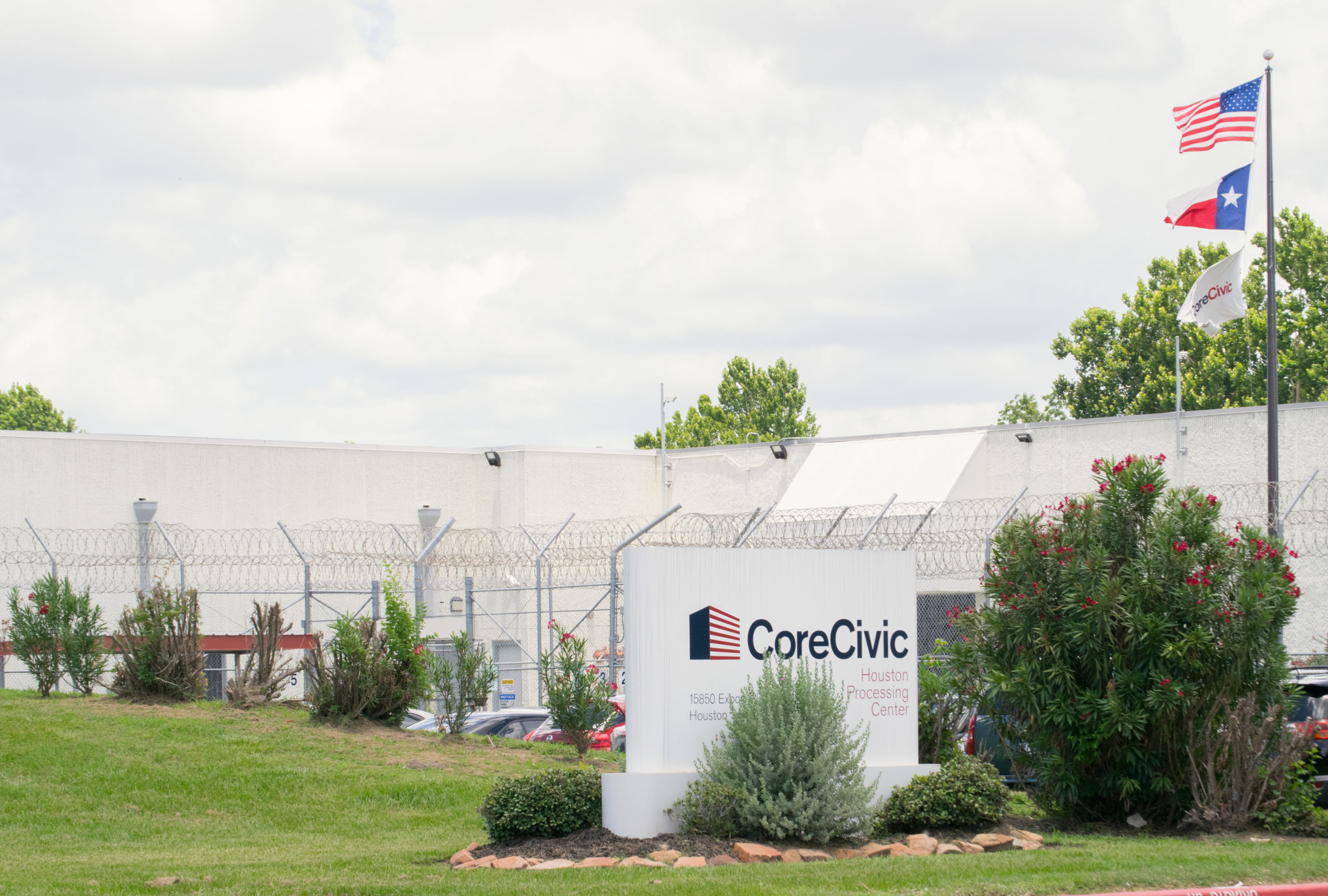How ICE is Using Private Contractors to Dodge Local Democracy
The agency is pursuing contracts with private detention providers to circumvent state and local efforts to curtail and regulate immigrant detention.
| May 26, 2020

This article originally appeared on The Appeal, which hosted The Political Report project.
The agency is pursuing contracts with private detention providers to circumvent state and local efforts to curtail and regulate immigrant detention.
After months of sustained pressure, immigrants’ rights activists clinched a major victory in Williamson County, Texas, in June 2018. In a room packed with local organizers, the county commission voted to terminate contracts with ICE and CoreCivic—the second-largest private detention company in the country—which together held 500 women in detention at the nearby T. Don Hutto Residential Center.
Yet the center didn’t close. ICE simply cut the local government out of the equation and signed a short-term contract directly with CoreCivic to keep the detention center open. It sought to lock in long-term control over the center and two other Texas detention centers by posting solicitations for 10-year private contracts.
The Trump administration’s draconian immigration enforcement has triggered growing pro-immigration activism around the country, and with it, increasing public pressure on elected officials to reevaluate their relationships to immigration detention. In the face of congressional inaction on immigration, many immigrants’ rights advocates have shifted their focus locally: to state, county, and municipal policymakers who can intervene directly in their jurisdictions to curtail ICE detention.
In response, the agency is creating a new playbook. It’s taking state and local efforts to block or limit its detention operations less as defeats than as temporary hiccups that it can overcome by pursuing direct contracts with its favored private providers. In some cases, ICE is combining this with finding jurisdictions with friendlier officials.
“We’re starting to see that when [local populations] become aware of how this agency is operating near their homes, they express some concern,” said César Cuauhtémoc García Hernández, a law professor at the University of Denver who studies immigration detention. “In many communities, that concern is developing into sufficiently well organized advocacy networks that are able to either pressure local governments to stop coordinating with or contracting with ICE, or at least make business as usual more difficult for private prison corporations.”
He added, “And so to the extent [ICE is] able to eliminate constituents in local governments or city governments, it’s a cleaner relationship that they can have with the private prison company.”
Williamson County Commissioner Terry Cook, who voted in favor of terminating the contracts, had predicted this in her comments just before the vote, expressing concern that “the facility does not have to close and can operate under emergency conditions with CoreCivic operating it.”
In an email to the Appeal: Political Report, Cook also expressed frustration with ICE’s ability to override the county’s decision-making and continue the detentions. “It is crazy for the taxpayers to pay over $100/day/person to hold them there—not like any of them are a danger to the general population,” she wrote. “Example of silliness of national politics.”
A local advocacy organization, Grassroots Leadership, has spearheaded the campaign against the center. It rallied residents to pack public meetings and call or write to their commissioners, demanding that they rely on alternative revenue sources. It is now suing ICE as part of a public records request seeking information on the contracting process that allowed it to so quickly ensure the facility would stay open.
—
The events in Williamson County are just one of the more straightforward examples of the emerging strategy. ICE has employed similar schemes over the past year in California and Michigan. “That’s why these strategies from ICE were developed, to kind of circumvent those victories in other places where there’s already a really robust campaign,” said Bárbara Suárez Galeano, organizing director at the Detention Watch Network.
At any given time, ICE detains tens of thousands of people around the country at sites that follow no unified template. They range from federal facilities to privately owned detention centers with whom ICE contracts to local jails and where county governments agree to hold ICE detainees in exchange for payments.
Most detentions still run through local governments in some form or another via contracts known as intergovernmental service agreements (IGSAs). Some counties take custody of ICE detainees directly and hold them in the same jails as local prisoners. Others enter these IGSAs and then subcontract with private prison companies to provide the detention services, as Williamson County used to. While this may seem like a redundant step, it has some benefits for ICE, which can avoid some contracting requirements by using the localities as a middleman, and for the contractors, which can get localities to build more infrastructure and provide other services for the centers.
In 2017, California adopted a law that restricted IGSAs, affecting ICE’s ability to use municipalities as pass-throughs and triggering a series of developments that have showcased ICE’s adaptability. It prohibited localities from entering into new agreements to hold immigration detainees, expanding existing agreements, or approving the use of new land or buildings for private detention without certain public notice and comment.
This inconvenienced ICE in Adelanto, a small jurisdiction in San Bernardino County with which the agency had a contract to operate a detention center run by The GEO Group. ICE wanted to expand this facility, but this law banned Adelanto from agreeing. So GEO’s CEO quietly urged city officials to terminate the contract, as reported by the Palm Springs Desert Sun, promising to keep paying it as if the contract was still active. This enabled ICE to turn around, contract with GEO directly, and expand its existing capacity by converting a local prison that was also owned by GEO into an immigration detention center.
This maneuver solved ICE’s local policy problems in the short-term, but new obstacles soon emerged: In October 2019, California adopted a new law that broadly prohibited the operation of private, for profit detention anywhere in the state; however, it enabled contracts in effect as of Jan. 1 to continue as scheduled until they reach completion.
ICE and its private detention partners kicked into gear. With only months to go until the Jan. 1 deadline, the agency quickly posted solicitations—essentially requests for private companies to bid on available contracts—that appeared tailored to existing detention centers, including the one in Adelanto, and got staggering 15-year contracts inked just ahead of the 2019 law going into effect. One of the other contracts is for the CoreCivic-run Otay Mesa Detention Center in San Diego, which as of this writing has the largest COVID-19 outbreak out of any ICE detention facility in the country, including the first death of an ICE detainee from the disease.
A similar operation is underway in McFarland, where two prisons would be converted into annexes of the Mesa Verda ICE Processing Center in Bakersfield—another facility that got a new long-term contract late last year—adding 1,400 immigration detention beds.
Though neither Adelanto nor McFarland would be a party in these new contracts, which are directly between ICE and the private prison companies, the 2017 law requires that each still approve the use of the prisons for immigration detention purposes. And this left an opening for local activists.
Late last year, when McFarland activists heard that ICE was seeking to incorporate the prisons into its detention ecosystem, they rallied public support among the heavily immigrant population of the city. “They were phone banking their neighbors, phone banking community members to make sure that these detention centers didn’t come into the immigrant town McFarland. All in all, before the second meeting [of the City Council], folks were able to have over 1,000 signatures in opposition to the detention centers,” said Alex Gonzalez, a community organizer with Faith in the Valley. The onset of the coronavirus pandemic somewhat stunted the organizing efforts as public meetings moved online.
Some of the organizing has even happened inside the facilities in question. Charles Joseph, who was detained at the Mesa Verde ICE Processing Center—the facility that the two McFarland prisons are supposed to be expanding—helped organize protests inside and has been vocal in speaking out against the center since his release in early April. He told the Political Report that in detention, he had been pressing ICE, GEO, and local officers to “put some preventive measures in place” to prevent COVID-19 outbreaks. Despite the encroaching threat of the virus, he believes the private prison companies don’t have an incentive to safeguard the health of the detainees and has called for local officials to prevent the expansions.
McFarland’s Planning Commission initially rejected the project, but last month its city council reversed that decision and authorized it, largely on the argument that it would prove an economic lifeline. González recalled that the company enticed McFarland city officials on promises to bring jobs, “millions of dollars of revenue,” and scholarships.
Among the council members who voted for the deal was Eric Rodriguez, a former employee of The GEO Group. Local advocates are attempting to challenge the decision as a violation of the 2017 law’s requirements for public input.
Approval of the extended GEO contract in Adelanto is still pending in the city council.
Suárez Galeano called the events in California “the most egregious” example of ICE’s emerging playbook of securing private partnerships to evade public terminations.
The agency moved in a similarly aggressive manner in Michigan after Governor Gretchen Whitmer, a Democrat, blocked the sale of a former state prison in Ionia County to Immigration Centers of America, a small, private detention contractor working with ICE.
Then, in April of this year, ICE informed the local Board of Commissioners that it would seek to begin building an entirely new detention center on a privately owned lot, a move that falls outside the governor’s power to block it. Last week, the board tabled a vote on a resolution supporting the proposal, citing a desire to get more information from ICE, but ultimately their input is not necessary for the project to move ahead.
In fact, the letter that ICE sent to the Board of Commissioners contains a number of details, such as the size of the facility and the exact lot to be used, that suggest the agency has already sketched out a project and either selected a contractor or is going to dictate to a contractor exactly what it wants.
“What’s strange about this is that normally ICE itself doesn’t play the front role in siting detention centers. They are at least somewhat subject to government procurement practices,” said Judy Greene of the New York-based advocacy and research organization Justice Strategies, who has been following the situation. “I have not seen an instance where the party that seems to be handling the negotiations or the communications with local officials and so forth is ICE directly.”
ICE is asserting such control that it’s essentially moving forward without having publicly announced a contractor to build and run the facility. Attempts to reach the owners of the potential site were unsuccessful, and a local ICE spokesperson didn’t respond to a request for comment. Representatives for The GEO Group and the Management and Training Corporation, another private detention firm, told the Political Report they were not seeking the contract, a representative for CoreCivic directed a reporter to ICE, and ICA did not respond.
—
This kind of strategy—ICE going in and doing the legwork itself or bestowing a favored contractor with the project and letting it execute it on agency’s behalf—could become handy as the agency keeps developing a rapid-response playbook to dodge state and local attempts at asserting control.
“Their decisions have a local effect, but they’re not beholden to a particular municipality or particular county,” said García Hernández. He explained that private corporations like GEO and CoreCivic “are very capable of operating in a diverse range of settings … They measure their risk in light of developments happening around the United States or even in some instances around the world, more so than they do based on risks in any particular county or even city.”
ICE sees some benefits from going through localities, but there are also definite advantages to cutting them out. “The small-D democratic process is always messy,” said García Hernández. Not every state is going to take as drastic a step as California, but in his estimation, ICE views its response to the state’s efforts “as something that isn’t necessarily a plug-and-play model, but a model that they can learn from.”
There are other similar scenarios on the horizon. ICE has an active solicitation for a contract detention facility to serve its Chicago field office. If a private provider buys or builds a center directly on behalf of the agency, ICE would have circumvented a recent Illinois law that prevents local governments from contracting with ICE to provide it detention services.
Similarly, in Minnesota, ICE is soliciting bids for a private detention center in St. Paul, as the legislature eyes axing counties’ ability to contract with ICE in their local jails.
In Hudson County, New Jersey, the local board of freeholders voted to let an IGSA to hold ICE detainees at the Hudson County Jail expire at the end of 2020. ICE hasn’t solicited contracts with a new facility in the area, but it could present another tempting opportunity.
Rosa Santana of the legal services and advocacy group First Friends of New York and New Jersey said that ICE would most likely seek to distribute detainees to other local jails and detention centers, but it would be “extremely unfortunate” if another private center was built. She pointed to the CoreCivic-run Elizabeth Contract Detention Facility, also in New Jersey. The center had the first reported case of COVID-19 in an immigration detention center and is now facing a significant outbreak.
“It is extremely hard to hold [CoreCivic] accountable for what happens in their facilities,” she told the Political Report in a written message.

